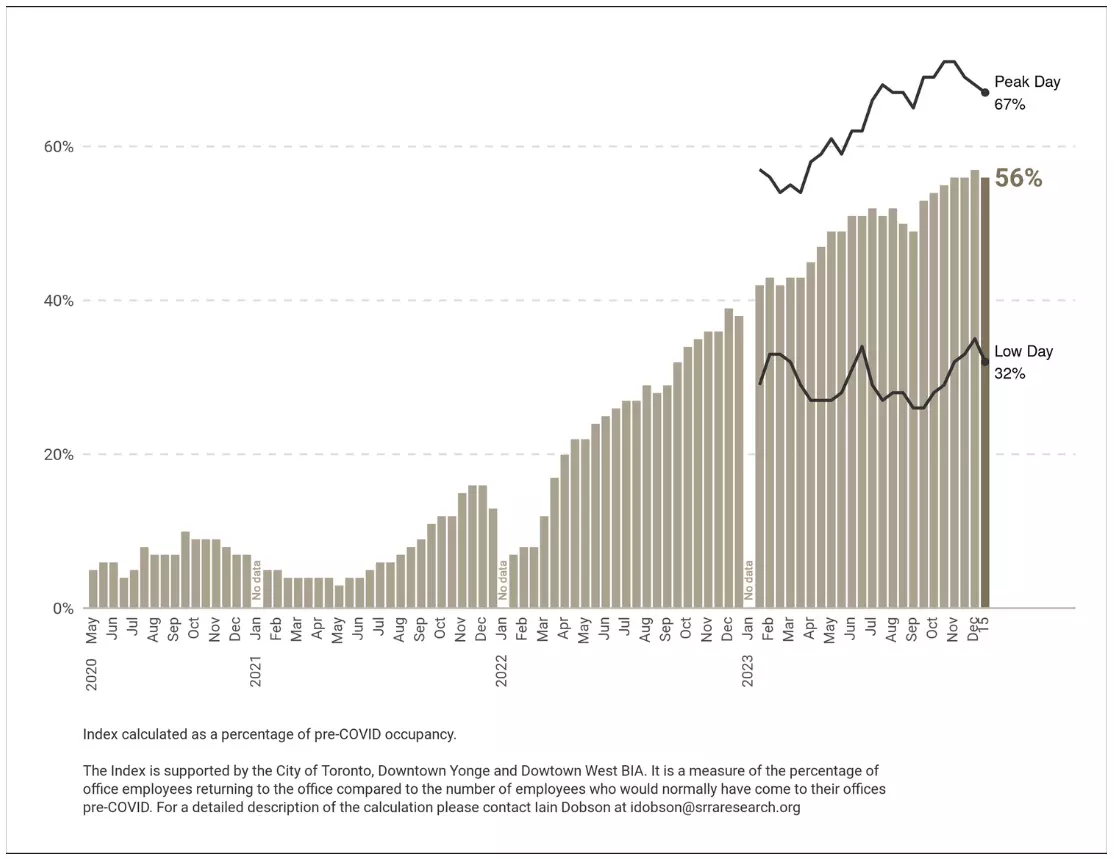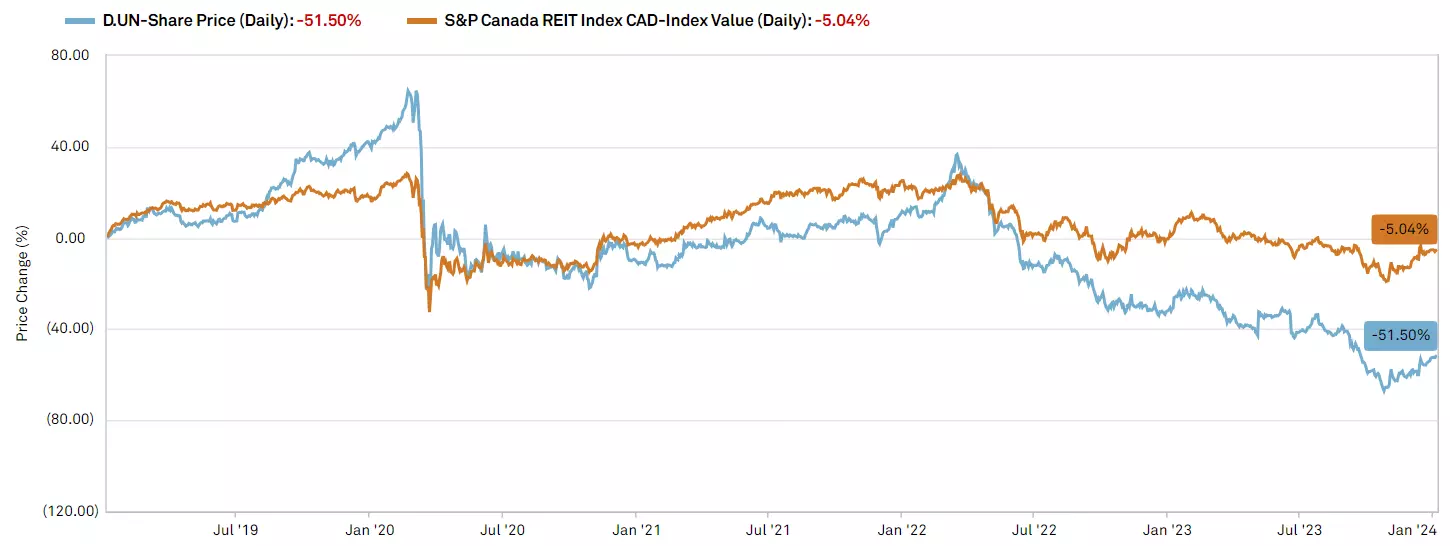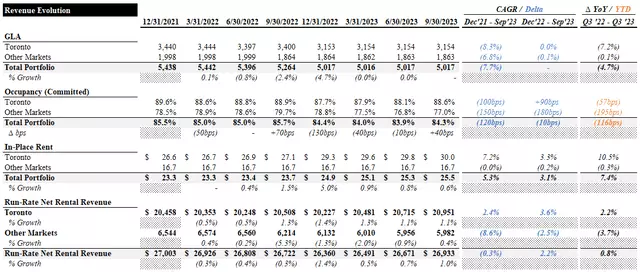 Image source: CHUNYIP WONG
Image source: CHUNYIP WONG
Dream Office Real Estate Investment Trust (TSX:D.UN:CA / OTC:DRETF / "Dream") is an externally managed office REIT focused on downtown Toronto. Like many office REITs, it has faced significant challenges in recent years. In this article, we will explore the office sector, assess the pessimism surrounding it, and search for deep-value opportunities. Our analysis indicates that the sell-off and underperformance of Dream REIT are warranted, primarily due to the adverse effects of the COVID-19 pandemic and the prevailing work-from-home trend. While Dream has tried to offset these challenges through unit repurchases, the negative impact is still apparent.
Dream's external manager, Dream Unlimited, has also reduced its stake in the REIT through a substantial issuer bid ("SIB") in June '23. This move raises concerns about Dream's long-term prospects and its reliance on financial engineering to manage a heavily oversupplied market. Although rate cuts may help close the discount to net asset value (NAV), the likelihood of a distribution cut, the ongoing oversupply, and consistent insider selling post-SIB have led us to remain cautious.
History
Dream is an office REIT externally managed by Dream Unlimited, concentrating its portfolio predominantly in downtown Toronto. Over the past eight years, Dream has been actively involved in a capital recycling program, divesting non-core assets to focus on its key downtown Toronto properties. Currently, it owns 26 income-producing properties, with an additional two under development, totaling approximately 4.9 million square feet of gross leasable area (GLA). Around 65% of its owned GLA is in downtown Toronto, with the remaining spread across other markets.
The impacts of COVID-19 on office properties are well-documented, and while Toronto has shown stronger in-office attendance compared to other cities, uncertainties remain. The recovery of the office sector depends on factors such as future remote work policies and their impact on supply and demand equilibrium. Despite these uncertainties, recent leasing data confirms that offices are still in demand. However, the market faces challenges in terms of portfolio occupancy, lease rates, and leasing costs.
 Image source: Downtown Toronto Occupancy Index (SRRA)
Image source: Downtown Toronto Occupancy Index (SRRA)
Despite the necessity of office space for many industries, office REITs have suffered significant downturns. The persistent work-from-home trend, rising interest rates, increasing vacancy rates, and elevated new supply have led to softening market rents and soaring leasing and build-out costs. These negative trends have made office REITs unattractive investments.
In an attempt to boost its share price, Dream's management initiated a substantial issuer bid ("SIB") in June '23. However, the fact that Dream Unlimited sold a significant portion of its units in Dream through the SIB raises questions about the management's confidence in the REIT's value. Despite a partial recovery in share price, Dream continues to trade below the SIB price. This insider selling is a significant factor in our decision to rate Dream as a sell.
Portfolio Snapshot
Dream's owned portfolio consists of 28 properties with approximately 4.9 million square feet of gross leasable area. The downtown Toronto portfolio comprises 17 properties, while the Other Markets segment includes nine properties, primarily located in Calgary and the Greater Toronto Area.
 Image source: Portfolio Snapshot (Empyrean; Dream)
Image source: Portfolio Snapshot (Empyrean; Dream)
Dream's top 10 tenants account for around 36% of gross rental revenue and 29% of owned GLA, with an average credit rating of A+. The tenant profile, with a focus on professional services, finance, and insurance sectors, is favorable.
Recent Performance
Earnings & Cash Flow Evolution
Analyzing Dream's earnings and cash flow evolution from Q4 '21 to Q3 '23 reveals some concerning trends. Rental revenue has declined at a compound annual growth rate (CAGR) of 4%, partially offset by growth in common area maintenance recoveries, parking revenue, and property management and other revenue. Property operating expenses have grown modestly, resulting in a decline in net operating income (NOI) and declining NOI margins.
 Image source: Revenue Evolution (Empyrean; Dream)
Image source: Revenue Evolution (Empyrean; Dream)
Dream's funds from operations (FFO) and adjusted funds from operations (AFFO) have declined at CAGRs of 24% and 34%, respectively, during the same period. The payout ratios have increased, raising concerns about the sustainability of the distribution. A distribution cut is likely, and even with a potential cut, the yield would be around 7.5%.
NAV Evolution
Dream's net asset value (NAV) has declined approximately 22% since Q4 '21. The decrease in the value of investment properties, driven by cap rate expansion and modest NOI growth, has contributed to this decline. Reported NAV per unit has grown at a CAGR of 5%, primarily due to a reduction in the unit count.
 Image source: NAV Evolution (Empyrean; Dream)
Image source: NAV Evolution (Empyrean; Dream)
However, we have doubts about the reported NAV per unit and management's confidence in its accuracy. The optimistic assumptions about market rents and cap rates do not align with the challenging market conditions.
Leverage
Dream's debt-to-gross asset value (D/GAV) is approximately 68%, and net debt-to-EBITDAFV is approximately 12x. These leverage levels raise concerns, especially considering the uncertain supply-demand balance and its implications for cash flow. Dream's interest coverage ratio (ICR) has also deteriorated, increasing the likelihood of a distribution cut. Deleveraging the business through asset sales would be a last resort, given the challenging financing environment and the gridlocked private office market.
 Image source: Debt Summary (Empyrean; Dream)
Image source: Debt Summary (Empyrean; Dream)
Valuation
Dream is currently trading at 7.6x and 11.2x last quarter annualized FFO and AFFO, respectively. The valuation implies a discount to NAV of approximately 27% and an implied cap rate of around 6.6%. Despite the discount to NAV, we do not consider the valuation compelling given the risks and uncertainties discussed.
 Image source: Valuation Summary (Empyrean; Dream)
Image source: Valuation Summary (Empyrean; Dream)
Risks & Catalysts
The main risks for Dream include elevated vacancy rates, increasing leasing costs, and uncertainties regarding the recovery of the office sector. The glut of available office space in downtown Toronto has allowed tenants to negotiate favorable terms, including substantial concessions and incentives from landlords. Despite recent improvements in utilization and demand, it will take time for the market to stabilize. Moreover, new lease agreements signed with long terms further delay improvements in market fundamentals.
Conclusion
Considering the risks and uncertainties surrounding Dream Office REIT, we rate it as a sell. The challenges faced by the office sector, Dream's high leverage, and the doubts regarding its reported NAV and valuation indicate that there are better investment opportunities elsewhere. While the units may experience temporary price fluctuations, we do not believe the current valuation justifies holding onto Dream.

















